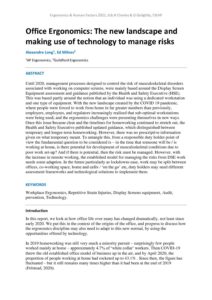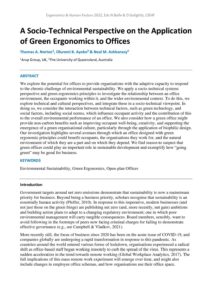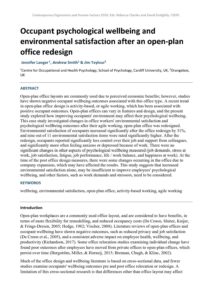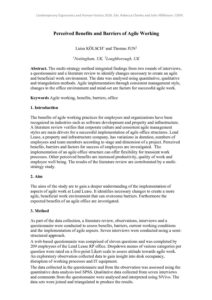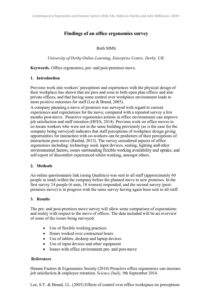Office ergonomics
Office Ergonomics: The new landscape and making use of technology to manage risks
| Document | Author Alexandre Long, Ed Milnes |
| Abstract Until 2020, management processes designed to control the risk of musculoskeletal disorders associated with working on computer screens, were mainly based around the Display Screen Equipment assessment and guidance published by the Health and Safety Executive (HSE). This was based partly around the notion that an individual was using a dedicated workstation and one type of equipment. With the new landscape created by the COVID 19 pandemic, where people were forced to work from home in far greater numbers than previously, employers, employees, and regulators increasingly realised that sub-optimal workstations were being used, and the ergonomics challenges were presenting themselves in new ways. Once this issue became clear and the timelines for homeworking continued to stretch out, the Health and Safety Executive published updated guidance, which distinguished between temporary and longer-term homeworking. However, there was no prescriptive information given on what temporary meant. To untangle this, from a responsible duty holder point of view the fundamental question to be considered is – in the time that someone will be / is working at home, is there potential for development of musculoskeletal conditions due to poor work set-up? And if there is potential, then the risk must be managed. However, with the increase in remote working, the established model for managing the risks from DSE work needs some adaption. In the future particularly as lockdowns ease, work may be split between offices, co-working space, home and cafés / ‘on the go’ etc, duty holders may need different assessment frameworks and technological solutions to implement them. |
A Socio-Technical Perspective on the Application of Green Ergonomics to Offices
| Document | Author Thomas A. Norton, Oluremi B. Ayoko & Neal M. Ashkanasy |
| Abstract We explore the potential for offices to provide organisations with the adaptive capacity to respond to the chronic challenge of environmental sustainability. We apply a socio-technical systems perspective and green ergonomics principles to investigate the relationship between an office environment, the occupants working within it, and the wider environmental context. To do this, we explore technical and cultural perspectives, and integrate these in a socio-technical viewpoint. In doing so, we consider the interaction between technical factors, such as green technology, and social factors, including social norms, which influence occupant activity and the contribution of this to the overall environmental performance of an office. We also consider how a green office might provide non-carbon benefits such as improving occupant well-being, creativity, and supporting the emergence of a green organisational culture, particularly through the application of biophilic design. Our investigation highlights several avenues through which an office designed with green ergonomic principles could benefit occupants, the organisations they work for, and the natural environment of which they are a part and on which they depend. We find reason to suspect that green offices could play an important role in sustainable development and exemplify how “going green” may be good for business. |
Physical and social isolation in various places of work
| Document | Author Anne Aidla, Helen Poltimäe, Kärt Rõigas & Eneli Kindsiko |
| Abstract Our results indicate that dealing with the consequences of physical and social isolation may be an issue not only for teleworkers but also for non-teleworkers. What is more, both types of isolation may manifest differently depending on the office type (single cell, shared cell, activity-based or open-plan) and the amount of time one works in the same room with co-workers. |
Occupant psychological wellbeing and environmental satisfaction after an open-plan office redesign
| Document | Author Jennifer Langer, Andrew Smith & Jim Taylour |
| Abstract Open-plan office layouts are commonly used due to perceived economic benefits; however, studies have shown negative occupant wellbeing outcomes associated with this office type. A recent trend in open-plan office design is activity-based, or agile working, which has been associated with positive occupant outcomes. Open-plan offices can vary in features and design, and the present study explored how improving occupants' environment may affect their psychological wellbeing. This case study investigated changes in office workers' environmental satisfaction and psychological wellbeing outcomes after their agile working, open-plan office was redesigned. Environmental satisfaction of occupants increased significantly after the office redesign by 31%, and nine out of 11 environmental satisfaction items were rated significantly higher. After the redesign, occupants reported significantly less control over their job and support from colleagues, and significantly more often feeling anxious or depressed because of work. There were no significant changes in other aspects of psychological wellbeing measured (job demands, stress at work, job satisfaction, fatigue, job performance, life / work balance, and happiness at work). At the time of the post office design measures, there were some changes occurring in the office due to company expansion, which may have affected the results. This study suggests that increased environmental satisfaction alone, may be insufficient to improve employees' psychological wellbeing, and other factors, such as work demands and stressors, need to be considered. |
Perceived Benefits and Barriers of Agile Working
| Document | Author Luisa KÖLSCH and Thomas JUN |
| Abstract The multi-strategy method integrated findings from two rounds of interviews, a questionnaire and a literature review to identify changes necessary to create an agile and beneficial work environment. The data was analysed using quantitative, qualitative and triangulation methods. Agile implementation through consistent management style, changes to the office environment and mind-set are factors for successful agile work. |
Findings of an office ergonomics survey
| Document | Author Ruth SIMS |
| Abstract |

